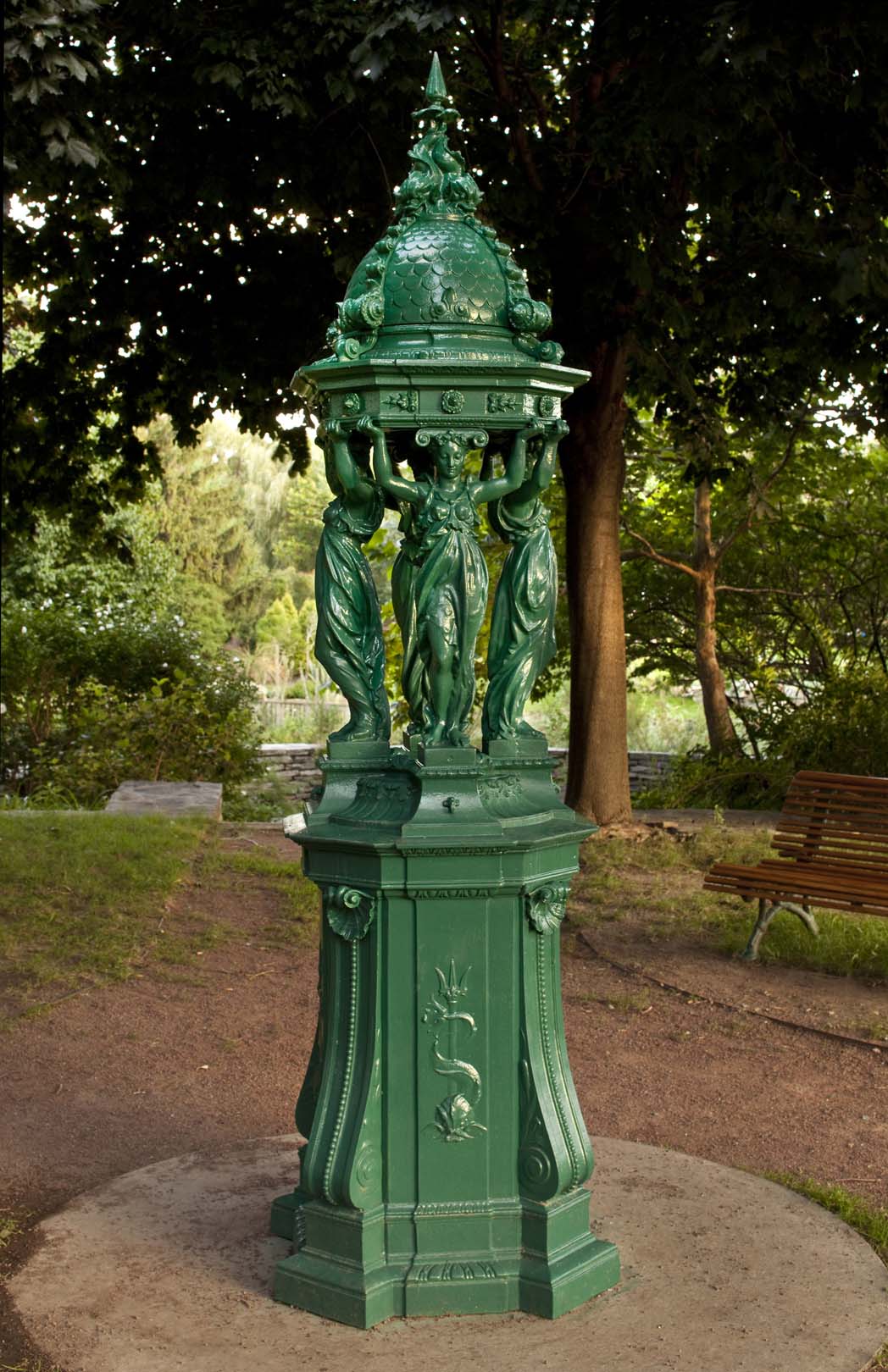Charles-Auguste Lebourg
Fontaine Wallace
1872
Presentation of the artwork
The fountain stands in the Floralies Gardens in Parc Jean-Drapeau, on Île Notre-Dame. Executed in iron founding, it is composed of six main elements: a pedestal, four caryatids, and a dome. The square pedestal, in neo-Renaissance style, presents a trident and a stylized dolphin on each of its faces, and rising from the base of each corner is a vault terminating in a shell. On top of the pedestal, four caryatids, topped with a scroll, hold up the dome that conceals the basin from which the water flows. Covered with a dragon-scale pattern and punctuated with various decorative elements, the dome echoes the theme of the dolphins on the pedestal.The caryatids – columns in the form of statues of women – represent simplicity, kindness, temperance, and charity. They are the twin sisters of the Three Graces, divinities of Antiquity that have been frequently portrayed throughout art history. These ones were inspired by a sixteenth-century artwork, by the French sculptor Germain Pilon, that was part of the funerary monument to Henry II.
Created to provide passersby with free access to drinking water, Wallace fountains testified to the importance of mechanization and industrialization during the Victorian era. At that time, through mass production and copying, not only did art objects become accessible to the general public, but by reproducing historically accepted models they could claim to be beautiful.
Associated events
The first Wallace fountain was installed in 1871 on Boulevard de la Villette in Paris. It bore the name of the person who donated it to the city of Paris, Sir Richard Wallace, a British philanthropist and art lover. A hundred Wallace fountains were to be installed in Paris, made from two models designed by the sculptor Charles-Auguste Lebourg. Forty of the fountains are still in operation today, and the one owned by the Ville de Montréal is the more widespread model. It was offered to the Ville de Montréal by the city of Paris in 1980, on the occasion of the Floralies international horticulture show.
Charles-Auguste Lebourg
Born in Nantes in 1829, Charles-Auguste Lebourg began his career in the studio of the famous sculptor François Rude. He then struck out on his own, and his production consisted almost exclusively of busts. Although he exhibited regularly in salons, he was best known for his designs of Wallace fountains (public drinking fountains). He died in Paris in 1906.
Presentation of the artwork
The fountain stands in the Floralies Gardens in Parc Jean-Drapeau, on Île Notre-Dame. Executed in iron founding, it is composed of six main elements: a pedestal, four caryatids, and a dome. The square pedestal, in neo-Renaissance style, presents a trident and a stylized dolphin on each of its faces, and rising from the base of each corner is a vault terminating in a shell. On top of the pedestal, four caryatids, topped with a scroll, hold up the dome that conceals the basin from which the water flows. Covered with a dragon-scale pattern and punctuated with various decorative elements, the dome echoes the theme of the dolphins on the pedestal.The caryatids – columns in the form of statues of women – represent simplicity, kindness, temperance, and charity. They are the twin sisters of the Three Graces, divinities of Antiquity that have been frequently portrayed throughout art history. These ones were inspired by a sixteenth-century artwork, by the French sculptor Germain Pilon, that was part of the funerary monument to Henry II.
Created to provide passersby with free access to drinking water, Wallace fountains testified to the importance of mechanization and industrialization during the Victorian era. At that time, through mass production and copying, not only did art objects become accessible to the general public, but by reproducing historically accepted models they could claim to be beautiful.
Associated events
The first Wallace fountain was installed in 1871 on Boulevard de la Villette in Paris. It bore the name of the person who donated it to the city of Paris, Sir Richard Wallace, a British philanthropist and art lover. A hundred Wallace fountains were to be installed in Paris, made from two models designed by the sculptor Charles-Auguste Lebourg. Forty of the fountains are still in operation today, and the one owned by the Ville de Montréal is the more widespread model. It was offered to the Ville de Montréal by the city of Paris in 1980, on the occasion of the Floralies international horticulture show.
Charles-Auguste Lebourg
Born in Nantes in 1829, Charles-Auguste Lebourg began his career in the studio of the famous sculptor François Rude. He then struck out on his own, and his production consisted almost exclusively of busts. Although he exhibited regularly in salons, he was best known for his designs of Wallace fountains (public drinking fountains). He died in Paris in 1906.




